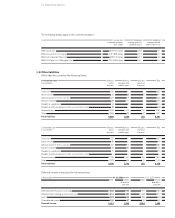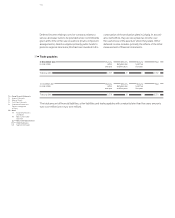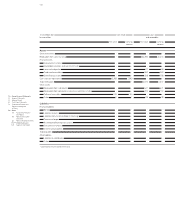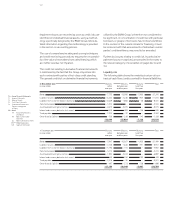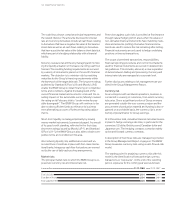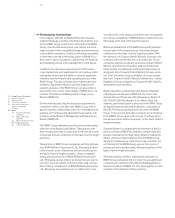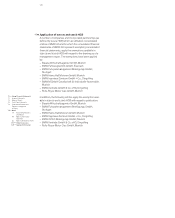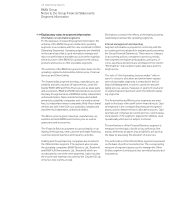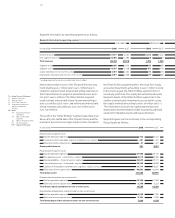BMW 2008 Annual Report Download - page 122
Download and view the complete annual report
Please find page 122 of the 2008 BMW annual report below. You can navigate through the pages in the report by either clicking on the pages listed below, or by using the keyword search tool below to find specific information within the annual report.
123 Group Financial Statements
in euro million 31.12. 2008 31.12. 2007
Euro / US Dollar 3,631 6,140
Euro / British Pound 2,291 3,484
Euro / Japanese Yen 835 1,263
The cash flows shown comprise principal repayments and
the related interest. The amounts disclosed for interest
rate and currency derivatives include all cash flows relating
to derivatives that have a negative fair value at the balance
sheet date as well as all cash flows relating to derivatives
that have a positive fair value at the balance sheet date but
which are part of a hedging relationship with a financial
liability.
Solvency is assured at all times by managing and monitor-
ing the liquidity situation on the basis of a rolling cash flow
forecast. The resulting funding requirements are secured
by a variety of instruments placed on the world’s financial
markets. The objective is to minimise risk by matching
maturities for the Group’s financing requirements within
the framework of the target debt ratio. The long-term ratings
published by Standard & Poor’s (A) and Moody’s (A2)
enable the BMW Group to obtain financing on competitive
terms and conditions. Against the background of the
current financial market and economic crisis and the re-
sulting impact on the automobile sector, Moody’s revised
the rating on February to “under review for pos-
sible downgrade”. The BMW Group will continue to be
able to raise sufficient funds to refinance its business
even after taking account of forthcoming rating adjust-
ments.
Short-term liquidity is managed primarily by issuing
money
market instruments (commercial paper). As a result
of its good credit standing, reflected in the first-class
short-term
ratings issued by Moody’s (P-1) and Standard
& Poor’s (A-1), the BMW Group is also able to obtain com-
petitive terms and conditions in this area.
Also reducing liquidity risk, additional secured and un-
secured lines of credit are in place with first-class interna-
tional banks. Intragroup cash flow fluctuations are evened
out by the use of daily cash pooling arrangements.
Market risks
The principal market risks to which the BMW Group is ex-
posed are currency risk and interest rate risk.
Protection against such risks is provided at first instance
through natural hedging which arises when the values of
non-derivative financial instruments have matching matu-
rities and amounts (netting). Derivative financial instru-
ments are used to reduce the risk remaining after netting.
Financial instruments are only used to hedge underlying
positions or forecast transactions.
The scope of permitted transactions, responsibilities,
financial reporting procedures and control mechanisms
used for financial instruments are set out in detailed inter-
nal guidelines. This includes, above all, a clear separation
of duties between trading and processing. Currency and
interest rate risks are managed at a corporate level.
Further disclosures relating to risk management are pro-
vided in the Group Management Report.
Currency risk
As an enterprise with worldwide operations, business is
conducted in a variety of currencies, from which currency
risks arise. Since a significant portion of Group revenues
are generated outside the euro currency region and the
procurement of production material and funding is also or-
ganised on a worldwide basis, the currency risk is an ex-
tremely important factor for Group earnings.
At December , derivative financial instruments were
in place to hedge exchange rate risks, in particular for the
currencies US dollar, British pound, Canadian dollar and
Japanese yen. The hedging contracts comprise mainly
option and forward currency contracts.
A description of how these risks are managed is provided
in the Group Management Report on page . The BMW
Group measures currency risks using a cash-flow-at-risk
model.
The starting point for analysing currency risk with this
model is the identification of forecast foreign currency
transactions or “exposures”. At the end of the reporting
period, exposures for the coming year were as follows:


